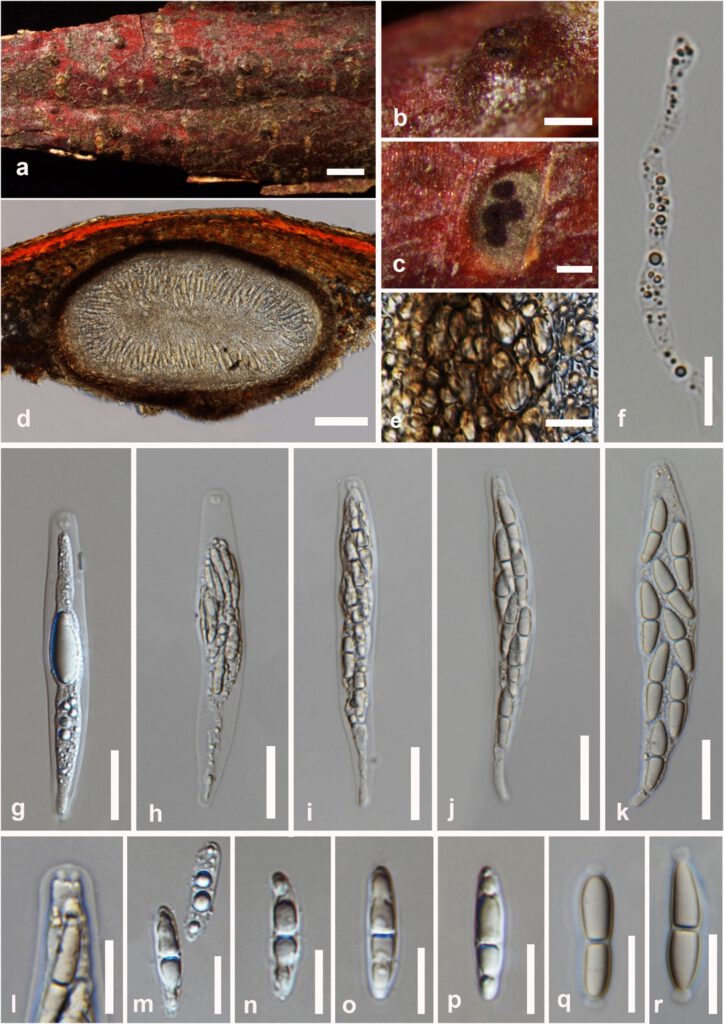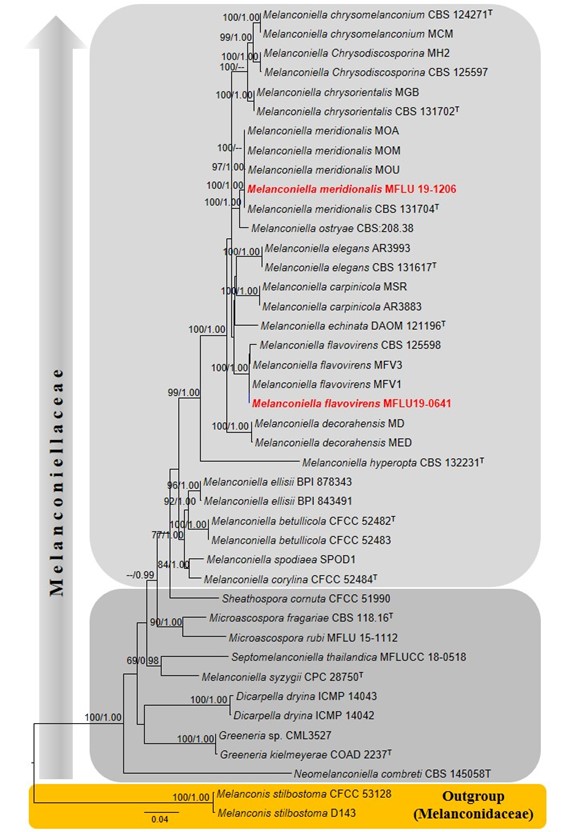Melanconiella meridionalis Voglmayr & Jaklitsch, in Voglmayr, Rossman, Castlebury & Jaklitsch, Fungal Diversity 57(1): 33 (2012)
MycoBank number: MB 800123; Index Fungorum number: IF 800123; Facesoffungi number: FoF 10701; Fig. 24
Saprobic on aerial branch of Ostrya carpinifolia Scop. Sexual morph: Pseudostromata 0.5–1.0 mm diam., scattered on substrate, indistinct, projecting up to 200–300 μm, circular, view as minute bumps, perithecial bumps distinct or inconspicuous. Ectostromatic disc typically inconspicuous, whitish to pale yellowish, concealed by ostioles. Entostroma whitish, well-developed. Ostioles 3–5 per disc, unevenly emerging in the disc, circular, slightly papillate, black. Perithecia 0.2–0.6 mm wide, immersed in host bark, oblong, aggregated unevenly in ectostromatic disc. Peridium 30–35 μm wide, composed of 4–6 layers, outermost layers comprising dark brown to pale brown cells of textura angularis, inner layers comprising pale brown to hyaline cells of textura angularis. Hamathecium 3–5 μm wide, hyaline, septate, paraphyses, deliquescent at maturity. Asci 100–120 ×10–20 μm (x̅ = 110 × 17 μm, n = 20), 8-spored, untunicate, broadly cylindrical to slightly fusoid, short pedicel, distinct apical ring with 3–4 μm wide. Ascospores 20–25 × 5–7 μm (x̅ = 23 × 6 μm, n = 40), overlapping, 2–3-seriate, ellipsoid to fusoid, 1-septate, with or without constricted at the septum, rounded or subacute at apex, hyaline, knob-like appendages with 2–3 μm long, monomorphic or dimorphic cells (larger upper cell), cells are distinctly triangular to ovate in outline, numerous guttules, smooth-walled. Asexual morph: discosporina-like, see Voglmayr et al. (2012).
Material examined – Italy, Province of Arezzo [AR], Valsavignone – Pieve Santo Stefano, dead branch of Ostrya carpinifolia Scop. (Betulaceae), 29 April 2019, Erio Camporesi, IT 4308, (MFLU 19-1206).
GenBank numbers – ITS: OM614594; LSU: OM616565.
Notes – Melanconiella meridionalis was introduced by Voglmayr et al. (2012) on Ostrya carpinifolia. The morphology of our strain (MFLU 19-0641) shares similar morphology to the strain (MOM=CBS 131704) by Voglmayr et al. (2012), with the less prominent guttules in ascospores. Phylogenetically, our strain MFLU 19-0641 groups with M. meridionalis strains (MOA, MOM=CBS 131704, MOU) with 100% MLBS and 1.00 BYPP support. These all strains form a sister clade to M. ostryae (CBS 208.38) (Fig. 25). Therefore, we identified our new strain as M. meridionalis, which is the second record from Tuscany, central Italy. This species has been recorded on Ostrya carpinifolia from Tuscany in the central region and Trentino in Trentino-Alto Adige/Südtirol in northern Italy. Many further taxa have been recorded from Ostrya carpinifolia (Voglmayr et al. 2012).

Figure 24 – Melanconiella meridionalis (MFLU 19-1206). a, b. Pseudostromata on a dead branch of Ostrya carpinifolia. c, d. Transverse and longitudinal sections of pseudostromata. e. Peridium. f. Paraphyses. g–k. Asci. l. Close up of apical ascus. m–r. Ascospores. Scale bars: a = 500 μm, b–d = 100 μm, f, g–k = 20, e, l–r = 10 μm.

Figure 25 – Phylogram generated from maximum likelihood analysis based on combined ITS, LSU, rpb2 and tef1-α sequenced data. Fourty four strains were included in the combined sequence analyses, which comprised 3,308 characters with gaps (ITS = 619, LSU = 820, rpb2 = 1028, tef1-α = 1332). Single gene analyses were also performed and topology and clade stability compared from combined gene analyses. Melanconis stilbostoma (D143, CFCC 53128) in Melanconidaceae was used as the outgroup taxon. Final ML Optimization Likelihood is (-lnL = 0.216701). The matrix included 781 distinct alignment patterns, with 25.21 % undetermined characters or gaps. Estimated base frequencies were obtained as follows: A = 0.242676, C = 0.249904, G = 0.290719, T = 0.216701; substitution rates AC = 0.611978, AG = 3.141798, AT = 1.301933, CG = 0.580412, CT = 4.913737, GT = 1.0; gamma distribution. Bootstrap support values for ML (first set) equal to or greater than 65% and BYPP equal to or greater than 0.95 are given above the nodes. The strains from the current study are blue bold and the type strains are indicated with T.
